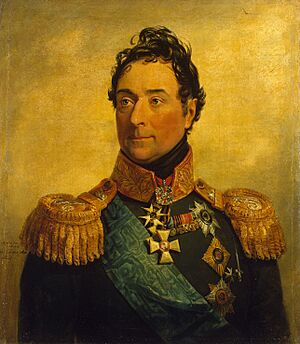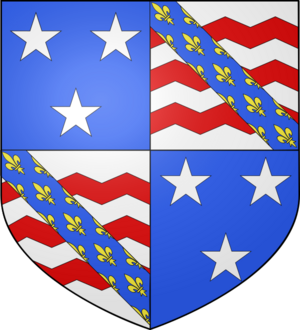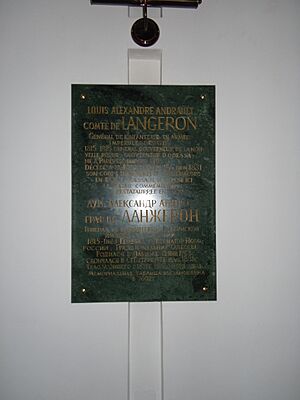Louis Alexandre Andrault de Langeron facts for kids
Quick facts for kids
Louis Alexandre Andrault de Langeron
|
|
|---|---|

Portrait by George Dawe
|
|
| Born | 24 January 1763 Paris, Kingdom of France |
| Died | 16 July 1831 (aged 68) Odessa, Russian Empire |
| Buried | |
| Allegiance | |
| Service/ |
Infantry |
| Years of service | 1778-1831 |
| Rank | General |
| Battles/wars | American Revolutionary War Russo-Swedish War (1788–90) Russo-Turkish War (1787–92) French Revolutionary Wars Russo-Turkish War (1806–12) Napoleonic Wars Russo-Turkish War (1828–29) |
| Awards | Order of the Holy Spirit Order of the Golden Fleece Order of St. Andrew Order of St. Anna Order of St. George Order of the White Eagle Order of St. Vladimir Order of Saint Louis Order of the Black Eagle Society of the Cincinnati |
| Other work | Governor of New Russia |
Count Louis Alexandre Andrault de Langeron was a brave soldier. He was born in Paris, France, in 1763. He served in the army of France. Later, he joined the army of the Russian Empire. He became a very important general. He is remembered for his military service and for helping to develop the city of Odessa.
Early Military Career
Louis Alexandre Andrault de Langeron came from a noble French family. He joined the French army when he was just 15 years old in 1779. He started as a junior officer.
He was sent to places like Caracas and Saint-Domingue (now Haiti). He also fought in the American Revolutionary War. This war helped the American colonies gain independence. Langeron was a special member of the Society of the Cincinnati. This group was for officers who fought in the American Revolution. You can see his special medal in his portrait.
By 1788, he had become a colonel in the French army.
Fighting in New Wars
When the French Revolution began, Langeron was a Royalist. This meant he supported the king. He left France and joined the Russian army in 1790.
He quickly showed his skills in battle. He fought against Sweden in the Russo-Swedish War (1788–1790). Then, he fought in the Russo-Turkish War (1787–1792). He was even wounded during the capture of Izmail. This was a very important battle led by the famous Russian general Alexander Suvorov.
Langeron was promoted to major general in 1797. A year later, he became a lieutenant general.
Napoleonic Wars Campaigns
Langeron played a big role in the Napoleonic Wars. These were major conflicts across Europe. He commanded a large group of soldiers at the Battle of Austerlitz. This was a famous battle that the French won. After this defeat, Langeron was sent to Odessa.
From 1806 to 1811, he fought in another Russo-Turkish War (1806–1812). He fought in many battles against the Ottoman Empire. For his bravery, he was promoted to General of the Infantry. This is a very high rank.
In 1812, Langeron led his troops in important battles. These included the Battle of Berezina. In 1813, he helped block the city of Toruń. He also fought in major battles like Bautzen and Leipzig.
The next year, he joined the campaign in France. He fought in battles like Laon and Paris. His troops even captured the Montmartre heights in Paris. In 1815, he became the governor of New Russia. This was a large area in the Russian Empire.
Life in Odessa
After the wars, Langeron returned to Odessa. He was made the Military Governor of Kherson and Odessa. He also commanded the Cossacks in the region. Under his leadership, trade and exports grew a lot in Odessa.
Langeron helped develop Odessa. He opened the Richelieu Lyceum. This was a school for the children of wealthy merchants and Greek immigrants. He also started the building of the Odessa Botanical Gardens and Primorsky Boulevard.
One of his most important decisions was making Odessa a free port in 1819. This meant that goods could be sold and stored there without paying customs taxes. This helped Odessa become a very important trading city. Today, a street and a beach in Odessa are named after him.
In 1823, Langeron retired due to poor health. He traveled to France for a few years. He returned to military service briefly in the Russo-Turkish War, 1828-1829. He fought against the Turks again. Louis Alexandre Andrault de Langeron died in 1831 during a cholera outbreak.
| Government offices | ||
|---|---|---|
| Preceded by Aleksandr Rudzevich as General-Governor of New Russia |
Military Governor of Kherson 1815–1822 |
Succeeded by Ivan Inzov as Governor-General of New Russia and Viceroy of Bessarabia |
| Preceded by Thomas Cobley as acting mayor |
Mayor of Odessa 1816–1820 |
Succeeded by Nikolai Tregubov |




